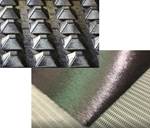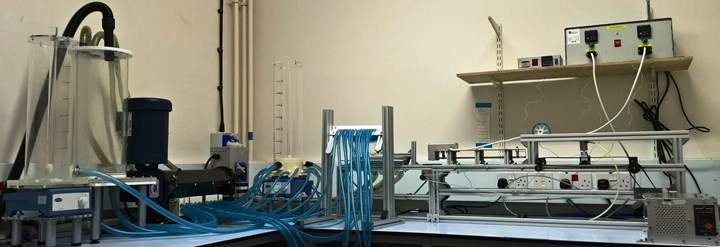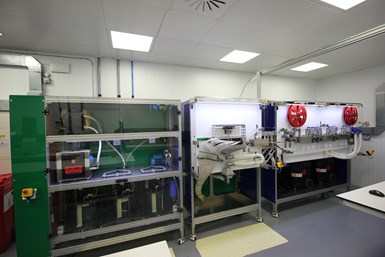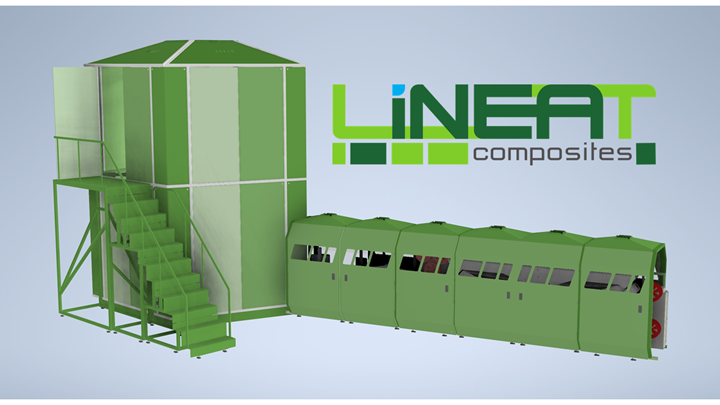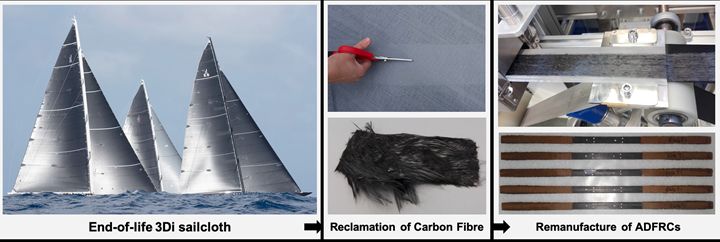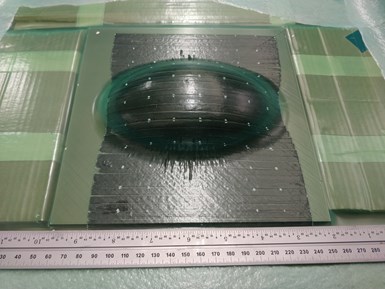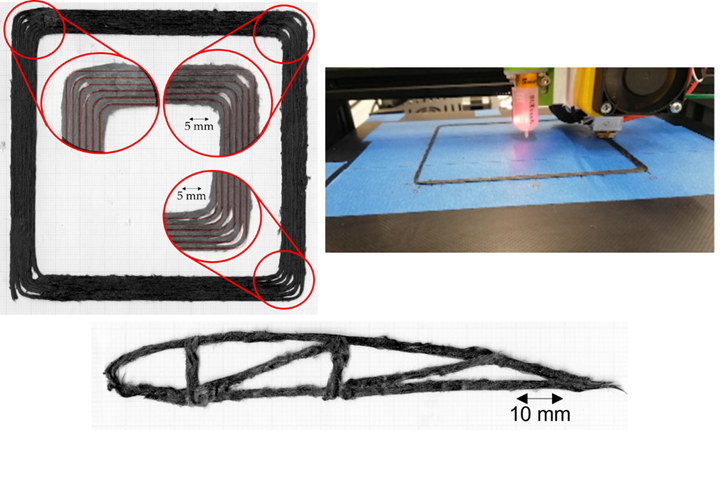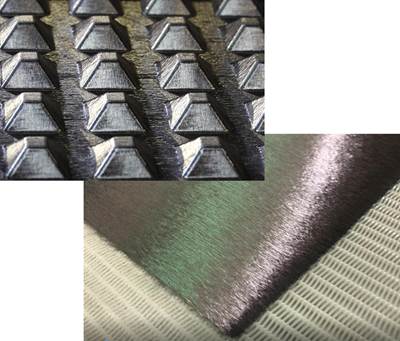Success from the start. The HiPerDiF process demonstrated its soundness from the very first benchtop prototype, which produced 5-millimeter-wide prepreg tape. The process consists of (1) spraying fibers from a water tank suspension through an alignment head; (2) drying the aligned fibers with heat; and (3) combining the dried fibers with a polymer film under heat and pressure. Photo Credit: Marco Longana (University of Bristol)
The vision cast nearly a decade ago by University of Bristol (U.K.) academics HaNa Yu and Kevin Potter, co-inventors of High Performance Discontinuous Fibre (HiPerDiF) technology, is multifaceted. To realize high-volume production of high-performance composite components, manufacturers need less expensive feedstock and faster, more automated fabrication processes — all without sacrificing the mechanical properties for which advanced composites are known.
Efforts to fulfill this vision have brought HiPerDiF to the threshold of commercialization. The process reduces raw material cost by using discontinuous fiber — the source of which will be recycled composites — and offers a high-volume, automated process that aligns discontinuous fibers within a prepreg tape. The final step, and a mandate of spin-out company Lineat Composites (Bristol, U.K.), is to leverage the superior forming properties of the aligned discontinuous architecture to support high-volume, automated fabrication of finished components.
The patented HiPerDiF technology employs a simple but effective three-stage process. The discontinuous fibers are suspended in a water tank and sprayed through an alignment head between narrow parallel plates. The change in momentum as the fibers strike the back plate causes them to rotate and align between the plates as they are sucked down to the mesh conveyor belt below, where the majority of the water is extracted.
The aligned tapes (fiber on backing film) are fully dried using a heater before being combined with a polymer film tape under heat and pressure. “The result is a prepreg tape with a high degree of alignment,” reports Ian Hamerton, National Composites Centre (NCC) professor of polymers and sustainable composites in the Bristol Composites Institute, University of Bristol, and a co-founder of Lineat Composites. “The payoff is the retention of up to 85% of the mechanical properties in the second-life advanced composite.”
Laboratory scale. HiPerDiF 2G, the second-generation laboratory-based machine, is still used for exploratory material combinations (low TRL efforts), producing short lengths of 5-millimeter-wide prepreg tapes. Photo Credit: Marco Longana (University of Bristol)
When CW last reported on the HiPerDiF process in 2019, work had been presented in a large number of research publications and had progressed from the prototype (retrospectively named “BabyDiF” by Marco Longana, a co-investigator with the HiPerDiF project almost from the beginning and also a co-founder of Lineat Composites) to a laboratory-scale machine, the HiPerDiF 2G. “However, we had reached the limit of what we could achieve in terms of scale as alignment suffered on larger production runs,” Hamerton continues. Work commenced to scale up the process while achieving consistently high-quality aligned discontinuous fiber-reinforced composite (ADFRC) prepregs.
Wider tapes, higher rate. The modular HiPerDiF 3G machine scales up prepreg manufacture, producing ADFRC tape up to 35 millimeters wide at up to 25 meters per hour. Photo Credit: Marco Longana (University of Bristol)
Next-gen HiPerDiF
A 2017 grant of £1 million from the Engineering and Physical Sciences Council (EPSRC, U.K.) enabled HiPerDiF’s academic team, led by Hamerton, to begin a full-scale redesign with the express aims of increasing tape width, production speed and quality. The team collaborated with STL Tech (Bristol, U.K.), which produced the control software for HiPerDiF 3G, a fully instrumented, 4-meter-long, modular system. This highly sophisticated research machine, located at NCC, is capable of producing 35-millimeter wide, highly aligned prepreg tapes at 25 meters per hour.
The next advancements toward commercial production volumes call for replacing the manual preparation of fiber mixtures and improving the machine that aligns the fibers. With funding from private investors and InnovateUK, Lineat is developing this commercial production line — said to be the first in the world — with an automated fiber input system and innovative alignment head assemblies. “The process lends itself to automation,” says co-founder and CTO of Lineat Composites Lourens Blok. “Once it is up and running, it takes relatively little adjustment. The aim is to have the least manual steps to go from raw bulk fiber to aligned fiber tape.”
Commercial volumes coming soon. The Lineat commercial alignment machine, modeled here and using the HiPerDiF process, is planned for completion in 2022. Photo Credit: Lineat Composites
In the meantime, ongoing HiPerDiF academic research has expanded the range of fibers and resins successfully incorporated into prepreg. Prepreg properties can be modified by varying the carbon fiber feedstock — for example, from 100% 3-millimeter-long PAN fibers to various ratios of 3- and 6-millimeter-long fibers, or PAN and pitch fibers. Carbon fiber-reinforced polymer (CFRP) laminates may feature 55% fiber volume, high stiffness (E = 115 GPa, σT ≈ 1,500 MPa), pseudo-ductile tensile behavior (εpd = 1.2%), or tailored damping. Current tape production is focused on a variety of commercial thermoset, thermoplastic and vitrimeric polymer matrices, as well as basalt and plant-derived fibers, to demonstrate improvements in laminate mechanical performance and enhance their sustainability — the subject of researcher Ali Kandemir’s doctoral work.
Indeed, sustainability is a critical objective of ongoing HiPerDiF research. In collaboration with the North Technology Group (Bridgeport, Conn., U.S.), HiPerDiF 3G is being used to demonstrate that sustainable manufacturing could be implemented in the marine composites industry. Doctoral researcher Marcelle Hecker is working to identify the best end-of-life (EOL) recycling method for the carbon fiber-reinforced 3Di sail. An ADFRC prepreg using reclaimed fiber with a bio-based epoxy from SHD Composites (Sleaford, U.K.) is currently being evaluated for maritime demonstrator components. The material has demonstrated up to 87.5% of the Young’s modulus (35 GPa) and 60% of the tensile stress (300 MPa) when compared with a laminate based on HiPerDiF aligned, short, virgin carbon fibers.
Second-life composites. Reclaimed carbon fiber from 3Di racing sails (North Sails) has the potential for re-use in a HiPerDiF prepreg for maritime composite components. This prospect is currently under evaluation by Bristol and the North Technology Group. Photo credit: Marcelle Hecker (University of Bristol)
Work with recycled carbon fiber is the focus of several HiPerDiF projects. NCC’s Recyclate Technology Development (RecTec) project has recently produced continuous 30-meter lengths of HiPerDiF prepreg using recycled carbon fibers with epoxy resin films. “This forms the critical part of the project in aiming to maximize the material performance of recycled carbon fibers with the alignment technology, to maintain the highest amount value of an initially expensive material source,” notes Jack Alcock, NCC advanced technology project lead. In the next phase, test panels fabricated from the tape will undergo mechanical testing to quantify the performance and complement earlier work on lifecycle cost analysis (LCA) for the alignment technology.
To illustrate the potential to recover thermoplastic matrix and fibers, and recombine them in a cascade of life cycles, the HiPerDiF team has expanded upon previously published work on polypropylene and nylon 6 composites. The new materials use thermoplastic resins like polylactic acid (PLA) that are more sustainable because they have a lower reliance on petroleum-based feedstocks. Researcher Burak Ogun Yavuz is using a combination of finite element simulation and experimental methods to manufacture complex parts from carbon fiber-reinforced PLA composites. His work is focused on improving manufacturing techniques with HiPerDiF tape to facilitate high-volume production.
Extreme formability. To demonstrate the shapable nature of a HiPerDiF prepreg, Lineat compared its performance in a seashell-shaped mold (left). While the ADFRC prepreg conformed well to the mold (center), continuous fiber-reinforced prepreg (right) did not fare as well. Photo credit: Lourens Blok (Lineat Composites)
Toward high-volume fabrication
If the proof of the pudding is in the eating, then no doubt the proof of ADFRCs is in fabricating components from this new composite material. Another project, “Fibre-steered Forming Technology,” led by the University of Bristol and funded by the EPSRC Future Composites Manufacturing Hub, has demonstrated the rapid production of a diaphragm-formed hemispherical structure using a single hand-laid HiPerDiF ply prepreg with Solvay Composite Materials (Alpharetta, Ga., U.S.) CYCOM 977-2 toughened epoxy matrix. The HiPerDiF prepreg has already been shown to yield superior formability compared to a continuous fiber-reinforced ply, even at room temperature. The same project is now combining HiPerDiF prepreg with continuous tow shearing technology, which has been commercialized by iCOMAT (Bristol, U.K.), to produce a small and highly complex dual curvature demonstrator component. Doctoral researcher Chantal Lewis is also putting CYCOM 977-2 HiPerDiF through its paces to test its resilience.
Vacuum forming. HiPerDiF CYCOM 977-2 prepreg has proven amenable to diaphragm vacuum forming at room temperature. Photo Credit: Ric Sun (University of Bristol).
A more radical departure is the use of HiPerDiF prepreg to produce feedstock for 3D printing processes. In his EPSRC-funded doctoral work, with support by the Thai government, Narongkorn Krajangsawasdi has devised a method to form carbon fiber-reinforced PLA (CF-PLA) filaments (carbon fiber volume of 35-42%) with a circular cross section. The material’s formability enables production of tight radii in complex specimens. Initial results exceed those reported for continuous CF-PLA: a tensile stiffness of 19 GPa and tensile strength of 122 MPa. Work is currently underway to produce carbon fiber-reinforced nylon (CF-PA) filaments based on HiPerDiF feedstock.
The commercial future
Headed by CEO and technical textile expert Gary Owen, Lineat Composites was launched in June 2021 at NCC under the consortium’s SME Affiliates Scheme. “Building a successful business case for HiPerDiF is driven by cost versus performance,” Owen has found.
3D printing with HiPerDiF. Initial work has shown great promise for using HiPerDiF carbon fiber-reinforced/PLA as feedstock in additive layer manufacturing. Photo Credit: Narongkorn Krajangsawasdi (University of Bristol)
Lineat’s Blok participated in a SETSquared ICURe customer discovery program, which ignited a passion for commercialization, he recalls. “For three months I stopped doing research and spoke to potential end-customers, suppliers, trade bodies and large carbon fiber producers and users full time; this was invaluable to understand the challenges in the composites market. There’s a lot of talk about sustainability, but it is the combination with unique formable behavior that will really drive aligned fiber materials forwards.”
Working together with the supply chain is expected to be a key to Lineat’s success. “Materials and manufacturing are heavily integrated for composites,” Blok says. “You can have a great material on paper, but if it doesn’t suit the customer process it won’t sell. Knowing how to navigate that is as important as producing a high-quality product.”
One outcome of the ICURe program is that Blok and Lineat have identified a key potential market for aligned fiber prepreg tapes. “The sports industry, including marine, is a very serious market for us, not just for its size, but it has challenging manufacturing geometries at high rates while there is little room for error in terms of performance and quality,” Blok says.
Owen anticipates significant market penetration for HiPerDiF materials over the next five years. “The two main reasons why you will see industry move to aligned fiber composites are (1) formability, being able to produce more complex parts in less time with less operations; and (2) cost, reducing manufacturer labor and material costs as Lineat’s upscaling efforts bring alignment costs down.”
Related Content
McLaren celebrates 10 years of the McLaren P1 hybrid hypercar
Lightweight carbon fiber construction, Formula 1-inspired aerodynamics and high-performance hybrid powertrain technologies hallmark this hybrid vehicle, serve as a springboard for new race cars.
Read MoreWelding is not bonding
Discussion of the issues in our understanding of thermoplastic composite welded structures and certification of the latest materials and welding technologies for future airframes.
Read MoreThe potential for thermoplastic composite nacelles
Collins Aerospace draws on global team, decades of experience to demonstrate large, curved AFP and welded structures for the next generation of aircraft.
Read MoreThe lessons behind OceanGate
Carbon fiber composites faced much criticism in the wake of the OceanGate submersible accident. CW’s publisher Jeff Sloan explains that it’s not that simple.
Read MoreRead Next
Revolutionizing the composites cost paradigm, Part 1: Feedstock
Highly-aligned, short-fiber Tailorable Universal Feedstock for Forming achieves aerospace properties, metal-like formability in zero-waste, fiber-to-parts pilot plant.
Read MoreGoing discontinuous, for continuous improvement
The HiPerDiF (High Performance Discontinuous Fibre) project is exploring an alternate way of producing high-performance carbon fiber composites: start with discontinuous, rather than continuous fibers.
Read MoreDeveloping bonded composite repair for ships, offshore units
Bureau Veritas and industry partners issue guidelines and pave the way for certification via StrengthBond Offshore project.
Read More

